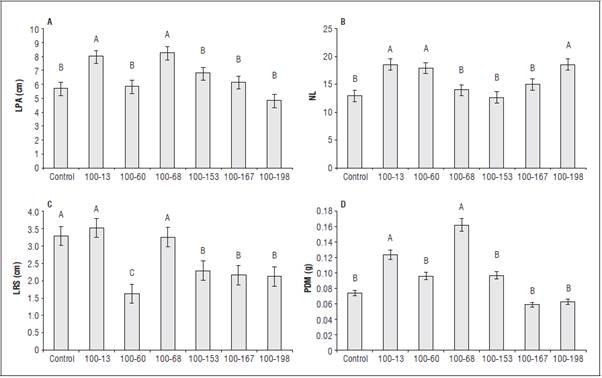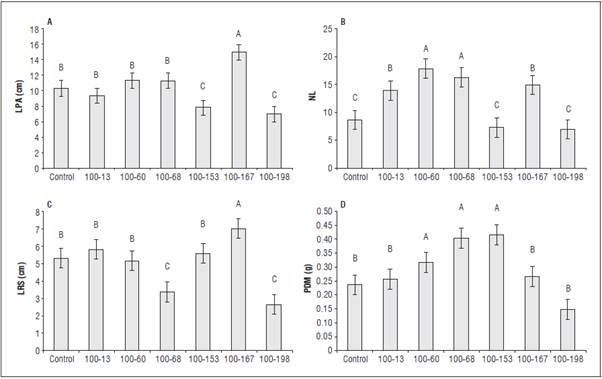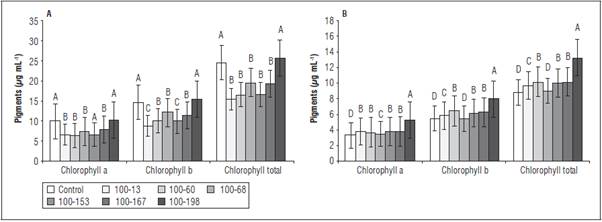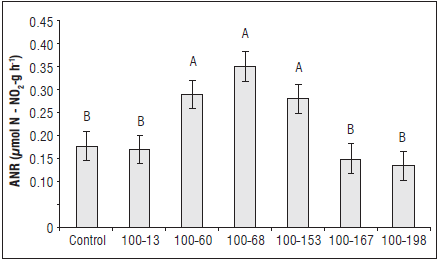INTRODUCTION
Bromeliads are found in tropical regions, with around 70% of the genus having been identified and 40% of the species being native to Brazil. Ornamental pineapple belongs to the Bromeliacae family and is a species of great economic value, the third most sold bromeliad in the world. It is cultivated in Thailand, Costa Rica, Brazil, the Philippines, Indonesia and In dia (FAO, 2016).
Ananas comasus var. bracteatus is a native species widely used in landscaping to outline garden areas and flowerbeds (Oliveira et al., 2010), which is pe rennial and easily grown, and is appreciated for its beautiful leaves and flowers. One of the issues with its large-scale use, however, is the difficulty in finding seedlings with a high genetic and phytosanitary qual ity that meets the demands of the consumer market.
Conventional propagation methods for bromeliads generate a low number of shoots, as well as high in dices of spreading disease (Matos et al., 2009). In this context, alternative methods such as stem sectioning (Freitas et al., 2012), propagation of the fruit crown (Santos et al., 2011) and micropropagation (Baldotto et al., 2010) are being investigated to try to minimize these problems.
Bromeliad micropropagation techniques produce healthy and standardized plants (Matos et al., 2009; Baldotto et al., 2010). However, plants obtained through in vitro cultivation have deficient anatomical and physiological characteristics, such as low quan tities of cerinas, heterotrophic metabolism, thinner cuticles and external periclinal walls of the epider mal cells, low stomatic density (Barboza et al., 2006), poorly functioning roots and inactive photosynthetic structures (Souza et al., 2009). During acclimatiza tion, they can present low survival rates (Hazarika, 2006), increasing the price of plants produced using this technology, which hampers their uptake by or namental plant and floral producers.
A reduction of losses during the acclimatization phase can be achieved using better acclimatization periods (Berilli et al., 2011), leaf fertilization (Bregonci et al., 2008) and inoculation of micropropagated plants with diazotrophic bacteria, which have presented positive results in terms of adaptation to environmental changes by seedlings from in vitro pineapple cultivation (Baldotto et al., 2010).
Diazotrophic bacteria present beneficial effects on plant growth, such as biological fixation of nitrogen (Li et al., 2008) and solubilization of phosphate. They are also antagonistic to pathogenic species, produce plant hormones (indole-3-acetic acid - AIA) and promote plant growth (Moreira and Siqueira, 2002; Moreira et al., 2010). The AIA produced by these bac teria can increase the length and number of radicular hairs, increasing the exploration area of roots, there by providing greater nutrient and water absorption and tolerance to low soil humidity conditions (Ryan et al., 2008; Moreira et al., 2010; Cassán et al., 2014).
Oliveira et al. (2006) related that results demonstrate the feasibility of the inoculation technology using diazotrophic bacteria in micropropagated sugarcane and plants grown in soils with low to medium levels of fertility. Dias et al. (2009), using diazotrophic bac teria strains, verified promoted root and plant shoot development. The plant growth promotion correlat ed with IAA production and phosphate solubilization. Bacterial effects could potentially be harnessed to promote plant growth during seedling acclimati zation in strawberry.
Inoculation with diazotrophic bacteria can be a viable acclimatization strategy for pineapple plants propa gated in vitro, producing hardier plants adapted to field conditions. Therefore, the present study aimed to determine the potential of diazotrophic bacteria for in vitro and ex vitro growth of ornamental Ananas comousus var. bracteus pineapple plants.
MATERIAL AND METHODS
In vitro culture
The present study was conducted in the Plant Bio technology Laboratory of the Universida de José do Rosário Vellano (UNIFENAS), Alfenas-MG and es tablished June, 2016. The plants were obtained with pineapple axillary buds culture (Ananas comosus var. bracteatus L.), which were inoculated in MS medium salts (Murashige and Skoog, 1962): 1.0 mg L-1 of BAP and 30 g L-1 of sucrose, solidified with 6 g L-1 of agar and pH adjusted to 5.8 before autoclaving at 121°C for 20 min. Plants in the third subcultivation were stored in a growing room for 60 d with a temperature of 24±2°C, 16h photoperiod and photosynthetic photon flux density of 36 µmol m-2 s-1.
Six diazotrophic bacterial strains belonging to the collection of the Agricultural Microbiology Laborato ry of the UNIFENAS were isolated from soil samples and Brachiaria decumbens plant tissues, collected from soil located in southern Minas Gerais (Tab. 1). These strains have been tested for their potential to pro mote the growth of plants by Florentino et al. (2017) and Terra et al. (2019).
Table 1 Identification, medium used for bacteria isolation and morphological characteristics of strains cultured in FAM me dium containing bromothymol blue as pH indicator.

JNFb, Johanna nitrogen fixing bacteria medium; LGI, Lipman Glicose Ivo medium; FAM, initials used by the developer of medium (Magalhães and Döbereiner, 1984); NFb, nitrogen fixing bacteria medium; EPS, production of exopolysaccharides.
The bacterial strains were preserved in water ac cording to the Romeiro (2001) methodology and reactivated and cultivated in a liquid FAM medium (Magalhães and Döbereiner, 1984) for 3 d, enough time to reach the log growth phase, around 109 UFC/ mL. Prior to the inoculation with the bacteria together with the explant, the capacity of the strains (Tab. 1) to produce 3-indoleacetic acid (AIA) in Dygs medium, both with and without (100 µg mL-1) Tryptophan (Trp) was evaluated, according to the methodology described by Pedrinho et al. (2010). The experiment design was completely randomized, consisting of six bacterial strains in combination with tryptophan (presence/absence), totaling 12 treatments with four repetitions.
Inoculation of diazotrophic bacteria
The plants established in the previous phase were standardized with approximately 2 cm of length, with an aerial part and root system, inoculated in a solid medium containing ¼ of the concentration of the MS medium salts, with 5 g L-1 sucrose and 7 g L-1 agar, and maintained under these conditions for 30 d.
The treatments were composed of different diazotrophic bacterial strains: UNIFENAS 100 (13, 60, 68, 153, 167 and 198) and a control treatment. The ex perimental design was completely randomized, con taining seven treatments with three repetitions and three plants per parcel.
Diazotrophic bacteria were inoculated together with the plants in vitro for a period of 7 d, with the appli cation of 1 mL of cultivation medium with the bac teria added to 1 mL of the previously described MS culture medium (¼), totaling 2 mL of solution per container for the different treatments. In the control treatment, only 2 mL of MS medium (¼) were added. The cultivation was conducted in a growing room at a temperature of 25°C, with a 12-h photoperiod and light intensity of 36 µmol photons m-2 s-1.
Acclimatization
After the in vitro culture, the plants were transferred to containers (100 cm3) with the commercial Plantmax® substrate and maintained in an arco model greenhouse with plastic covering and shade cloth sid ing (50% shading), with a temperature between 16 and 29°C±1°C and 70% UR. The plants were main tained under these conditions for a period of 60 d.
Evaluations
IAA Quantification. The indole acetic acid (IAA) concentration was evaluated using the colorimetric quantitative method (Gordon and Weber, 1951) during the log phase for bacterial growth, present ing approximately 109 UFC/mL. The estimation of the IAA quantification during the in vitro cultivation of diazotrophic bacteria was realized with the help of the standard-curve previously obtained with the sterilized Dygs medium and with the known IAA concentrations (0, 25, 50, 75 and 100 µg mL-1). The absorbance reading was realized using a spectrophotometer with a 5353 nm.
Phytotechnics. The height of the aerial part, number of leaves, root system length and plant dry mass were evaluated.
Chlorophyll content and nitrate reductase enzyme activ ity. For the chlorophyll content analysis, two fully expanded leaves were collected by repetition. 0.1 g of leaf was macerated in 5 mL of 80% acetone. The extract was filtered through fiberglass, and the vol ume was completed with 10 mL of 80% acetone. The readings were realized at 663 and 647 nm with a light absorption spectrophotometer (A) (Arnon, 1949). For the calculation of chlorophyll (µg chlorophyll/ mL), the following equations were used: chlorophyll a = (12.25xA663) - (2.79xA647); chlorophyll b = (21.50xA647) - (5.10xA663); total chlorophyll = chlo rophyll a + chlorophyll b.
The Nitrate reductase enzyme activity (ANR) was deter mined using the methodology proposed by Cataldo (1975). Leaves were cut into small pieces, and 200 mg were placed in a 15 mL test tube with a stopper that contained 4 mL of KNO3 0.25 M in phosphate buffer. Subsequently, 1 mL of alpha-napthylamine and 1 mL of sodium acetate buffer were added, completing the volume with 50 mL of distilled water. The reading was realized with a Spectrophotometer adjusted to 540 nm. Both evaluations were realized at the end of plant acclimatization.
The data were submitted to analysis of variance (ANOVA) using the statistical program Sisvar 5.3 (Ferreira, 2011), with the values compared using the Scott-Knott test at 5% probability.
RESULTS AND DISCUSSION
The IAA production was directly affected by the in teraction (P≤0.05) of the factors (bacterial strains and tryptophan). The use of tryptophan (TRP) in the culture medium promoted greater indole acetic acid (IAA) production, mainly with the UNIFENAS 100-60, 100-68, 100-153 and 100-198 strains, as com pared with the strains cultivated in the culture me dium without TRP (Tab. 2).
Table 2 Indol acetic acid (IAA, µg mL1) production by bacterial strains in Dygs medium, with and without tryptophan.

Means with different capital letters in a column and lower case in a row indicate a significant statistical difference according to the Scott-Knott test (P≤0.05) (n=4)±standard error. *A TRP absence of tryptophan; P TRP, presence of tryptophan.
Biosynthesis of auxins by bacteria occurs via different metabolic pathways (Spaepen et al., 2007), with TRP being the main precursor for IAA synthesis - a fact that explains the high indole values detected in the culture mediums that had TRP in comparison with those that did not, except for the 100-167 UNIFENAS and 100-13 UNIFENAS strains, which produced high IAA concentrations both with and without TRP (Tab. 1). Similar results were observed by Baldotto et al. (2010), who found higher IAA synthesis values in bromeliad seedlings cv. Vitória when adding TRP to the culture mediums. Studies developed by Pedrinho et al. (2010) and Florentino et al. (2017) showed that the Ab-V5 strain produced a greater quantity of IAA when cultivated in medium containing TRP (Tab. 2).
The results for the bromeliads cultivated in vitro and inoculated with different bacterial strains showed greater growth in the aerial part (LPA) of the plants cultivated in vitro with the UNIFENAS 100-13 and UNIFENAS 100-68 strains, 2.5 cm larger than plants cultivated in the control treatment (Fig. 1A). This greater growth of the aerial part led to greater accu mulation of dry mass in plants cultivated in vitro and inoculated with the UNIFENAS 100-13 and 100-68 strains (Fig. 1D).

Figure 1 A) length of aerial part (LAP); B) length of root system (LRS); C) number of leaves (NL); D) plant dry mass (PDM) of ornamental pineapple plants cultivated in vitro 30 d with diazotrophic bacteria. Means with different letters indicate significant statistical difference according to the Scott-Knott test (P≤0.05) (n=4)±standard error.
The plants inoculated with the UNIFENAS 100-13, UNIFENAS 100-60 and UNIFENAS 100-198 strains presented a larger number of leaves (NL) (Fig. 1B). The size of the root system (LRS) of the in vitro bromeliad plants was directly affected by the bacte rial strains, with UNIFENAS 100-13 and UNIFENAS 100-68 strains providing greater growth. However, they did not differ from the control treatment, which was greater than the other treatments (Fig. 1C).
Of the strains tested, it was found that inoculation with UNIFENAS 100-13 led to a significant effect on all the evaluated parameters, LPA, NL, LRS and PDM, which could be related to IAA production by this strain, both with and without TRP (Tab. 1). However, it was observed that the other strains, such as UNIFENAS 100-68, UNIFENAS 100-60 and UNI-FENAS 100-198 also contributed significantly to in vitro cultivation of ornamental pineapple, suggesting a need for further research taking into consideration the possibility of co-inoculation.
During the acclimatization process in the ex vitro cul tivation, the strains directly affected plant growth (Fig. 2). The UNIFENAS 100-167 strain provided greater growth for the aerial part (LPA) (Fig. 2A). The UNIFENAS 100-60, UNIFENAS 100-68, UNIFENAS 100-153 strains promoted dry mass accumulation (PDM) (Fig. 2AD), which was greater than in the other treatments (Fig. 2D). The inoculation of the plants with better strains resulted in an increase of 1.5 and 5.0 cm for LPA, accumulating 30 to 60% more PDM than in the plants submitted to the control treatment (Fig. 2AD).

Figure 2 A) length of aerial part (LAP); B) length of root system (LRS); C) number of leaves (NL); D) plant dry mass (PDM) of ornamental pineapple plants cultivated ex vitro (acclimatization) 60 d with diazotrophic bacteria. Means with different letters indicate a significant statistical difference according to the Scott-Knott test (P≤0.05) (n=4)±standard error.
The NL and LRS were also affected by inoculation in plants with different strains (Fig. 2, B and C). A great er LRS was observed in the plants inoculated with the UNIFENAS 100-167 strain. For NL, inoculation of plants with the UNIFENAS 100-60 and UNIFENAS 100-68 strains presented a greater number of leaves (Fig. 2B). Inoculation with bacteria led to greater dry mass and root numbers in acclimatized bromeliad cv. Vitória plants (Silva et al., 2016), which was observed for some strains in the present study (Fig. 2).
The promotion of plant growth through inocula tion with diazotrophic bacterial strains has already been observed in some agricultural species, such as tomato (Szilagyi-Zecchin et al., 2015), rice (Sabino et al., 2012), and lettuce (Schlindwein et al., 2008; Flo rentino et al., 2017). The beneficial effects of inocula tion with these bacteria are related to the fixation of nitrogen, solubilization of phosphate, their antago nistic action against pathogenic species and produc tion of plant hormones such as auxins, all of which promote plant growth (Moreira et al., 2010).
Generally, the pigment levels were greater in the in vitro culture than in the ex vitro cultivation (Fig. 3). This may be related to the lower light intensity dur ing cultivation in the growing room (in vitro), making the plants invest more in biosynthesis of pigments, seeking to compensate for the reduction in photosyn thesis as a result of the low light intensity. Amâncio et al. (1999) and Carvalho et al. (2001) reported that an increase in light intensity during acclimatization diminished the pigment levels in grape vines in an in vitro culture.

Figure 3 Content of pigments in ornamental pineapple plant inoculated with diazotrophic bacteria in vitro (A) and ex vitro (B) conditions. Means with different letters indicate a significant statistical difference according to the Scott-Knott test (P≤0.05) (n=4)±standard error.
The UNIFENAS 100-198 strain and control treat ment presented higher a, b and total chlorophyll levels in the in vitro culture than in the other treat ments (Fig. 3A). During the acclimatization process of the ex vitro plants, similar to what was observed with plants cultivated in vitro, the UNIFENAS 100 198 strain presented higher a, b and total chlorophyll levels. However, the control treatment of ex vitro plants presented lower a, b and total chlorophyll lev els (Fig. 3B). Inoculation with bacterial strains pro moted higher a, b, and total chlorophyll levels than in the non-inoculated plants (Fig. 3B).
The higher photosynthetic pigment levels in the plants inoculated with different bacterial strains when compared with the control plants (Fig. 3) could be related to nitrogen, probably as a result of the bio logical fixation of nitrogen (Li et al., 2008). Nitrogen is a nutrient positively correlated with an increase in pigment levels in the leaves (Argenta et al., 2001; Lima et al., 2009). In this research, it was observed that the contribution of bacteria promoted plant growth by providing IAA and nitrogen to plant metabolism, re sulting in the biomass accumulation observed in the plants during acclimatization (Fig. 2).
The UNIFENAS 100-60, 100-68 and 100-153 bacte rial strains promoted nitrate reductase enzyme ac tivity (ANR) (Fig. 4). Nitrate reductase is linked to a reduction of nitrate to nitrite that is subsequently transformed into ammonia and finally assimilated in glutamine by glutamine synthetase (Taiz et al., 2017).

Figure 4 Nitrate reductase enzyme activity (ANR) in ex vi tro ornamental pineapple plants with diazotrophic bacteria. Means with different letters indicate a significant statistical difference according to the Scott-Knott test (P≤0.05) (n=4)±standard error.
Donato et al. (2004) and Marcos et al. (2016) indicated that the influence of bacteria on nitrogen metabolism is via an increase in ANR, which increases the entry of nitrate and, consequently, promotes an increase in the nitrogen levels in the plant with a greater re sulting growth. This may have positively influenced the growth of the plants inoculated with the UNIFENAS 100-60, 100-68 and 100-153 strains (Fig. 4), which presented a greater ANR, as well as a greater dry mass accumulation (PDM) (Fig. 2D). The greater ANR activity could be considered for both the biolog ical fixation of nitrogen and the promotion of greater nitrate absorption by the bacteria (Bashan and Levanony, 1990).















